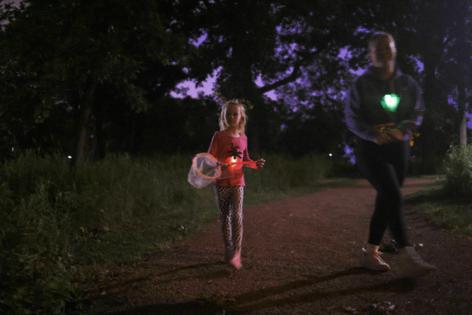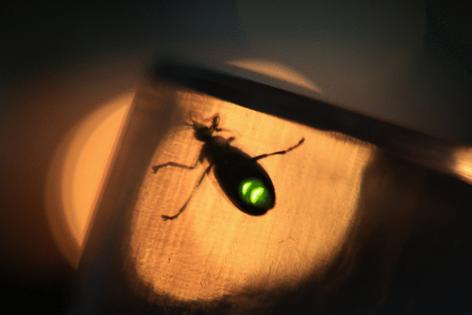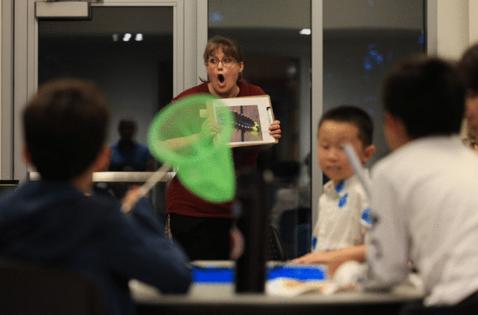Swarms of fireflies in Illinois this summer give enthusiasts hope that insect can overcome population decline
Published in Science & Technology News
CHICAGO -- Beatriz Swanson can remember the first time she saw the blinking glow. She was 10 years old, growing up in Mexico, when two fireflies appeared in front of her, floating away before she could carefully capture them in her hands.
Swanson did not see the shining insects again until she moved to upstate New York 17 years after her first encounter. Riding in a car at dusk, a cloud of fireflies caught her eye, still holding their allure after all those years.
“I couldn’t believe how many we saw,” Swanson said. “I told my husband to stop. I was like a child watching. I was in such awe seeing such beauty. So since then, I’ve loved them.”
Now a Plainfield resident, Swanson, 51, joined over a dozen other insect fans on a recent hike in Bolingbrook, where she caught two fireflies in a jar, watching them blink back and forth briefly, before she set them free.
Many people across the U.S. share Swanson’s sentiment for fireflies, which are classified as beetles. Reports of fewer fireflies in recent years have sparked worry for the future of the insect’s population. However, increased sightings this summer have boosted hopes for the survival of the insect. On the Friday night hike, wind and an impending thunderstorm did not prevent swarms of fireflies from darting among open grasses and shimmering between trees in the forest.
According to researchers, climate change and other factors like development, light pollution and pesticides are threatening firefly populations.
Because most data is anecdotal, scientists cannot easily determine whether fireflies are declining or increasing in different areas, said Richard Joyce, endangered species conservation biologist and coordinator of the Firefly Atlas, a tracking project by the conservation group Xerces Society.
With an estimated 179 species of fireflies in the U.S., different species require varying habitats, which affects how threatened they are, Joyce said. Firefly species that live in wetlands, for example, might be facing a population decline as their habitat is diminished by development.
“I do think it is safe to say that many species of fireflies, their population have declined in the past few decades, just based on habitat loss, because that’s kind of a good proxy for firefly populations, in lieu of actually having data from people trapping or or counting fireflies out in the field,” Joyce said.
While also hard to track, the 26 firefly species found in Illinois may not be in immediate danger, according to the Firefly Atlas. However, the cypress firefly species is listed as vulnerable as of 2020 and six other species are listed as data deficient on the International Union for Conservation of Nature Red List of Threatened Species.
“(Data deficient) means that we don’t have a very good sense at all how they’re doing as a species,” Joyce said. “Maybe they’re doing fine. Maybe they’re even increasing, or maybe they’re on the brink of extinction, but we just have so little data, and that’s a very common thing for insects.”
Population influences
Despite the gaps in data, scientists agree that multiple factors affect the firefly population.
A major climate component is the impact weather can have on the life cycle and growth of a population before they appear in the sky, said Darin J. McNeil, a wildlife ecologist at the University of Kentucky, who conducted a study on the insect in 2024.
“(Firefly larvae) and their prey are very dependent on moist but not totally saturated soil. So they don’t want it to be like a swamp for most species, but they want some kind of moist soil,” McNeil said. “So if you have weather conditions that affect the soil, that’s going to have a profound effect on the fireflies.”
If the soil is too wet, it could flood larvae and eggs while overly dry soil could limit the insect’s ability to find food and reproduce. Because these conditions affect larvae, they are likely to influence the number of fireflies two to three years later, contributing to annual fluctuations in population, McNeil said.
“Climate is a major driver of firefly abundance in the United States, so you might expect that shifts in climatic conditions would also probably have big effects on where fireflies are abundant and where they’re not, but also other things, too, (like) characteristics of the soil,” McNeil said.
Pesticides and herbicides can also negatively affect firefly populations. Ingesting the chemicals can kill larvae, change their eating and reproductive patterns, and eliminate their food sources. Habitat loss from the construction of roads, sidewalks and buildings that block access to the soil limits larvae development, he said.
Light pollution plays a role in inhibiting mating. When fireflies blink and glow in the sky they are often trying to attract a mate in the grass. Outdoor artificial lighting can confuse the fireflies, who are then unable to find each other.
However, people can help fireflies in simple ways by turning off outdoor lights when unneeded, limiting pesticides and herbicides, and creating the perfect habitat for larvae by keeping tall grasses, natural plants and fallen leaves, McNeil said.
“We leave most of our leaves in our yard, rake them to the margins of the yard and leave them there,” he said. “That gives the firefly larvae and the firefly eggs somewhere over winter, also gives a place for prey for the firefly larvae so that they can survive and do their thing.”
McNeil urged citizens to get involved with conservation groups like Xerces to help create a better understanding of the status of different species.
“I would just encourage people to look into doing Firefly Watch, even if you don’t have any fireflies in your yard at all … submit a form that says, hey, there’s 10 fireflies here, or zero fireflies here, or whatever,” McNeil said. “Even (if it’s) a yearly thing you and the kids or the grandkids (do), I think, can be a really valuable way to connect kids to nature and contribute data to a valuable cause.”
Charismatic beetle
The Morton Arboretum and the Chicago Botanic Garden are among the many places in the Chicago area with habitats that cater to fireflies.
At the arboretum, a mix of warm weather and open grasses and wildflowers have attracted more fireflies than staff have seen in previous years combined, said Plant Clinic Manager Spencer Campbell.
“They’re an insect that sparks curiosity and a desire for discovery and to witness them and to develop a personal relationship and a memory, which, you know, not all of our beetles are as charismatic as the firefly,” Campbell said. “I think we should make sure that every generation that follows us has those same opportunities to develop those deep bonds with the natural world.”
Regional events like the firefly hike, scheduled throughout the summer in multiple counties, aim to educate children and adults on conservation. These events often allow children to learn about fireflies firsthand, wielding nets and jars while experiencing the insect up close.
For Swanson, fireflies have an important role in creating childlike wonder in people of all ages. She said she could not imagine her grandchildren missing out on this opportunity.
“Whenever we are out and about and I see them … I’m just laughing and laughing and like a child,” Swanson said, “and it’s like, you cannot let go of that spirit of being a child inside.”
©2025 Chicago Tribune. Visit at chicagotribune.com. Distributed by Tribune Content Agency, LLC.












Comments